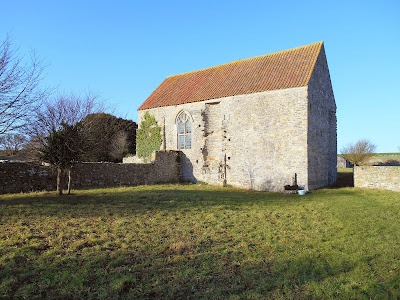Sets of stepping stones across rivers are rare in Somerset. The only two I have come across so far are across the River Barle near Withypool and across the River Brue in Bruton, just to the west of the packhorse bridge. According to the Somerset Historic Environment Record, the stepping stones in Bruton are modern and were put there sometime after 1982.
Friday, 14 October 2022
Stepping Stones
Saturday, 1 October 2022
Woodspring Priory
Woodspring Priory was founded at an unidentified location in Somerset called Dodlinch c1210 by William de Courtenay. By 1226 it had moved to its present location at Middle Hope to the north of Sand Bay. William de Courtenay’s grandfather, Reginald Fitz-Urse, was one of the knights who murdered Archbishop Thomas Becket in Canterbury Cathedral in 1170.
The name Woodspring derives from a spring in the area called the Worspring or Worspryng and the priory was called Worspring until the 18th century.
Woodspring Priory was of the double order of St Augustine and St Victor, and it was dedicated to the Holy Trinity, St. Mary the Virgin and St Thomas the Martyr of Canterbury. William de Courtenay provided the Manors of Woodspring, Worle and Locking to generate an income for the priory but it was never a very wealthy or large establishment. There were probably never more than ten members of the community living there at any one time.
The priory buildings were arranged around a central square cloister. The priory church was located to the north of the cloister, with the sacristy, dormitory and chapter house on the east side. The agricultural buildings were located to the west of the religious ones and were separated from them. The original chapel was replaced in the late 15th or early 16th century by the present church, which was built in the Perpendicular style. At around the same time an infirmary and tithe barn were built.
In 1534 Prior Roger Tormynton or Tormenton and the seven members of his community signed a declaration acknowledging the supremacy of King Henry VIII instead of the Pope and in 1536 Woodspring Priory was dissolved. Soon afterwards the infirmary, most of the church (except for the chancel, which was demolished) and the prior’s lodgings were converted into dwellings and to agricultural use.
The former priory changed hands several times before being acquired by the Pigott family (later the Smyth-Pigotts) in the late 17th century. It remained in their ownership for 200 years, although it was rented to a succession of tenants from the middle of the 19th century. In 1918 it was sold to Major Vernon Tickell Hill but he sold it to Richard Burrough a few years later.
In 1968 the
priory and adjoining land of Middle Hope were purchased by the National Trust. In
1969 the priory was taken over by the Landmark Trust, which spent 20 years restoring
the buildings. The surviving buildings
include the nave, north aisle and crossing of the priory church; the infirmary;
the tithe barn; a gatehouse and the 17th century farmhouse. The Landmark Trust now rents out the farmhouse
as holiday accommodation.








